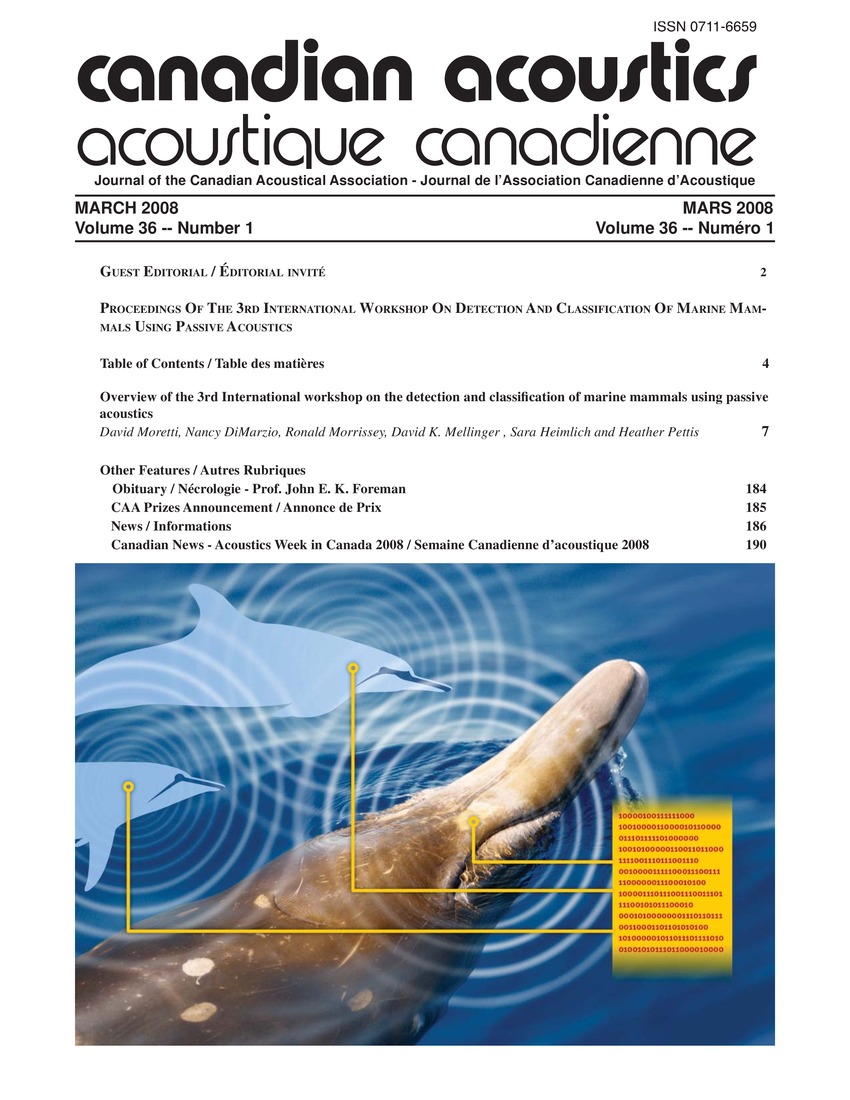Performance of three acoustical methods for localizing whales in the Saguenay - St. Lawrence Marine Park
Keywords:
Communication channels (information theory), Monte Carlo methods, Parks, Ray tracing, Speed, Ultrasonic velocity measurement, Uncertainty analysis, Marine parks, Monte-Carlo simulationsAbstract
Three algorithms are explored to localize fin whale calls recorded from a large-aperture hydrophone array deployed in the Saguenay - St. Lawrence Marine Park. The methods have to cope with varying sound speed in space and time, errors in time differences of arrival (TDoA) measurements in a noisy environment, and often a limited number of hydrophones having recorded a particular event. The array was composed of 5 AURAL autonomous hydrophones with a total aperture of about 40 km, coupled with 2 hydrophones from a small-aperture cabled coastal array. The autonomous hydrophones clock drifts were estimated with a level of uncertainty from timed sources and the coastal array time reference. The calls were then localized by constant-speed hyperbolic fixing, variable-speed isodiachron Monte-Carlo simulations, and a ray-tracing propagation model. The Monte-Carlo simulations generate clouds of possible localizations from the uncertainty in hydrophone positions, TDoAs and the effective horizontal sound speeds along the different source-hydrophone paths. The ray-tracing model produces a fixed grid of TDoAs which can then be consulted to find the likeliest positions of the whales. Results from the different methods are compared and their relative advantages or limitations are discussed.Additional Files
Published
How to Cite
Issue
Section
License
Author Licensing Addendum
This Licensing Addendum ("Addendum") is entered into between the undersigned Author(s) and Canadian Acoustics journal published by the Canadian Acoustical Association (hereinafter referred to as the "Publisher"). The Author(s) and the Publisher agree as follows:
-
Retained Rights: The Author(s) retain(s) the following rights:
- The right to reproduce, distribute, and publicly display the Work on the Author's personal website or the website of the Author's institution.
- The right to use the Work in the Author's teaching activities and presentations.
- The right to include the Work in a compilation for the Author's personal use, not for sale.
-
Grant of License: The Author(s) grant(s) to the Publisher a worldwide exclusive license to publish, reproduce, distribute, and display the Work in Canadian Acoustics and any other formats and media deemed appropriate by the Publisher.
-
Attribution: The Publisher agrees to include proper attribution to the Author(s) in all publications and reproductions of the Work.
-
No Conflict: This Addendum is intended to be in harmony with, and not in conflict with, the terms and conditions of the original agreement entered into between the Author(s) and the Publisher.
-
Copyright Clause: Copyright on articles is held by the Author(s). The corresponding Author has the right to grant on behalf of all Authors and does grant on behalf of all Authors, a worldwide exclusive license to the Publisher and its licensees in perpetuity, in all forms, formats, and media (whether known now or created in the future), including but not limited to the rights to publish, reproduce, distribute, display, store, translate, create adaptations, reprints, include within collections, and create summaries, extracts, and/or abstracts of the Contribution.


